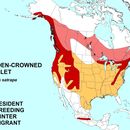fi
nimet breadcrumb-navigoinnissa


An extremely small (3 ½ inches) songbird, the male Golden-crowned Kinglet is most easily identified by its small size, olive-green body, black eye-stripe, black wings with white wing bars, and bright orange crown patch surrounded by a black ring. Female Golden-crowned Kinglets are similar, but have a yellow crown instead. Both sexes may be separated from the related Ruby-crowned Kinglet (Regulus calendula) by that species’ larger size, darker face, and white eye-ring. The Golden-crowned Kinglet breeds across southern Alaska, Canada, and the northern tier of the United States, extending south at higher elevations in the west as far as southern Arizona. In winter, most populations migrate south to the U.S. and northern Mexico, although some populations breeding in the mountain west and the northeastern U.S. migrate little if at all. Isolated non-migratory populations occur in central Mexico and Guatemala. Golden-crowned Kinglets breed primarily in northern and high-mountain evergreen forests. In winter, this species may be found in a variety of evergreen, deciduous, and mixed forests. Golden-crowned Kinglets primarily eat small insects and spiders, but will also eat fruit and seeds during the winter or when invertebrates are not available. In appropriate habitat, Golden-crowned Kinglets may be observed flitting through the forest canopy while plucking small invertebrates from leaves or evergreen needles. Birdwatchers may also listen for this species’ song, composed of several high-pitched “chip” notes ending in a lower-pitched whinny. Golden-crowned Kinglets are primarily active during the day.
Amerikanhippiäinen (Regulus satrapa) on pohjoisamerikkalainen varpuslintu. Sen elinympäristö käsittää Kanadan, Alaskan, Yhdysvaltain koillis- ja länsiosat, sekä Meksikon ja Guatemalan. Martin Lichtenstein kuvaili lajin holotyypin Pohjois-Amerikasta 1823.[2] Amerikanhippiäinen kasvaa vain 9 cm:n pituiseksi. Lintua on vaikea havaita sen etsiessä hyönteisiä havupuiden yläosista. Se rakentaa kuppimaisen pesänsä havupuun oksaan roikkumaan. Pesä on tehty sammalesta ja ruohosta ja vuorattu höyhenillä. Amerikanhippiäinen on osaksi muuttolintu, sillä pohjoiset linnut muuttavat talveksi etelämmäs.
Amerikanhippiäinen (Regulus satrapa) on pohjoisamerikkalainen varpuslintu. Sen elinympäristö käsittää Kanadan, Alaskan, Yhdysvaltain koillis- ja länsiosat, sekä Meksikon ja Guatemalan. Martin Lichtenstein kuvaili lajin holotyypin Pohjois-Amerikasta 1823. Amerikanhippiäinen kasvaa vain 9 cm:n pituiseksi. Lintua on vaikea havaita sen etsiessä hyönteisiä havupuiden yläosista. Se rakentaa kuppimaisen pesänsä havupuun oksaan roikkumaan. Pesä on tehty sammalesta ja ruohosta ja vuorattu höyhenillä. Amerikanhippiäinen on osaksi muuttolintu, sillä pohjoiset linnut muuttavat talveksi etelämmäs.